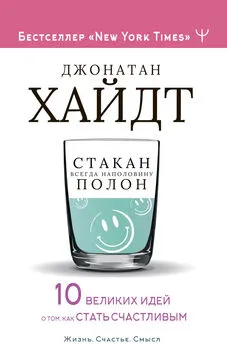Джонатан Хайдт - Стакан всегда наполовину полон! 10 великих идей о том, как стать счастливым
- Название:Стакан всегда наполовину полон! 10 великих идей о том, как стать счастливым
- Автор:
- Жанр:
- Издательство:Литагент АСТ
- Год:2020
- Город:Москва
- ISBN:978-5-17-119939-5
- Рейтинг:
- Избранное:Добавить в избранное
-
Отзывы:
-
Ваша оценка:
Джонатан Хайдт - Стакан всегда наполовину полон! 10 великих идей о том, как стать счастливым краткое содержание
Джонатан Хайдт изучил трактаты древних мыслителей и философские труды за последние 500 лет. Он смог вывести 10 Великих Идей Счастья, которые возникли на разных континентах и в разное время независимо друг от друга. Связь между здоровьем, работоспособностью, долголетием и мысленным настроем действительно существует! Но как перейти «на светлую сторону» и начать мыслить позитивно? Какой образ мышления стимулирует оптимизм? Как избавиться от хронической склонности к пессимизму и депрессии, научиться бороться с ложными тревогами и мнимыми опасностями? Вы найдете ответы в этой книге.
«Оригинально, серьезно, практически применимо, делает повседневную жизнь проще и лучше», – вот что говорят о книге многочисленные поклонники.
Стакан всегда наполовину полон! 10 великих идей о том, как стать счастливым - читать онлайн бесплатно ознакомительный отрывок
Интервал:
Закладка:
Nolen-Hoeksema, S., & Davis, C. G. (2002). Positive responses to loss. В сб.: C. R. Snyder & S. J. Lopez (Eds.), Handbook of positive psychology (pp. 598–607). New York: Oxford.
Nosek, B. A., Banaji, M. R., & Greenwald, A. G. (2002). Harvesting intergroup implicit attitudes and beliefs from a demonstration web site. Group Dynamics , 6, 101–115.
Nosek, B. A., Greenwald, A. G., & Banaji, M. R. (в печати). The Implicit Association Test at age 7: A methodological and conceptual review. В сб.: J. A. Bargh (Ed.), Automatic processes in social thinking and behavior. Philadelphia: Psychology Press.
Nussbaum, M. C. (2001). Upheavals of thought. Cambridge, UK: Cambridge University Press.
Obeyesekere, G. (1985). Depression, Buddhism, and work of culture in Sri Lanka. В сб.: A. Klineman & B. Good (Eds.), Culture and depression (pp. 134–152). Berkeley: University of California Press.
Olds, J., & Milner, P. (1954). Positive reinforcement produced by electrical stimulation of septal areas and other regions of rat brains. Journal of Comparative and Physiological Psychology , 47, 419–427.
Pachocinski, R. (1996). Proverbs of Africa: Human nature in the Nigerian oral tradition. St. Paul, MN: Professors World Peace Academy.
Pahnke, W. N. (1966). Drugs and mysticism. International Journal of Parapsychology , 8, 295–313.
Panthanathan, K., and Boyd, R. (2004). Indirect reciprocity can stabilize cooperation without the second-order free rider problem. Nature , 432, 499–502.
Park, C. L., Cohen, L., & Murch, R. (1996). Assessment and prediction of stress-related growth. Journal of Personality , 64, 71–105.
Pelham, B. W., Mirenberg, M. C., & Jones, J. K. (2002). Why Susie sells seashells by the seashore: Implicit egotism and major life decisions. Journal of Personality and Social Psychology , 82, 469–487.
Pennebaker, J. (1997). Opening up: The healing power of expressing emotions (Rev. ed.). New York: Guilford.
Perkins, D. N., Farady, M., & Bushey, B. (1991). Everyday reasoning and the roots of intelligence. В сб.: J. F. Voss, D. N. Perkins & J. W. Segal (Eds.), Informal reasoning and education (pp. 83–105). Hillsdale, NJ: Erlbaum.
Peterson, C., & Seligman, M. E. P. (2004). Character strengths and virtues: A handbook and classification. Washington, DC: American Psychological Association and Oxford University Press.
Piliavin, J. A. (2003). Doing well by doing good: Benefits for the benefactor. В сб.: C. L. M. Keyes and J. Haidt (Eds.), Flourishing: Positive psychology and the life well-lived (pp. 227–247). Washington, DC: American Psychological Association.
Pincoffs, E. L. (1986). Quandaries and virtues: Against reductivism in ethics. Lawrence, KS: University of Kansas.
Plomin, R., & Daniels, D. (1987). Why are children in the same family so different from one another? Behavioral and Brain Sciences , 10, 1–60.
Pronin, E., Lin, D. Y., & Ross, L. (2002). The bias blind spot: Perceptions of bias in self versus others. Personality and Social Psychology Bulletin , 28, 369–381.
Putnam, R. D. (2000). Bowling alone: The collapse and revival of American community. New York: Simon & Schuster.
Pyszcsynski, T., Greenberg, J., & Solomon, S. (1997). Why do we want what we want? A terror management perspective on the roots of human social motivation. Psychological Inquiry , 8, 1–20.
Pyszczynski, T., & Greenberg, J. (1987). Toward an integration of cognitive and motivational perspectives on social inference: A biased hypothesis-testing model. Advances in Experimental Social Psychology, 20, 297–340.
Reis, H. T., & Gable, S. L. (2003). Toward a positive psychology of relationships. В сб.: C. L. M. Keyes & J. Haidt (Eds.), Flourishing: Positive psychology and the life well-lived (pp. 129–159). Washington, DC: American Psychological Association.
Richerson, P. J., & Boyd, R. (1998). The evolution of human ultra-sociality. В сб.: I. Eibl-Eibesfeldt & F. K. Salter (Eds.), Indoctrinability, ideology, and warfare: Evolutionary perspectives (pp. 71–95). New York: Berghahn.
Richerson, P. J., & Boyd, R. (2005). Not by genes alone: How culture transformed human evolution. Chicago: University of Chicago Press.
Ridley, M. (1996). The origins of virtue. Harmondsworth, UK: Penguin.
Riis, J., Loewenstein, G., Baron, J., Jepson, C., Fagerlin, A., & Ubel, P. A. (2005). Ignorance of hedonic adaptation to hemodialysis: A study using ecological momentary assessment. Journal of Experimental Psychology : General, 134, 3–9.
Rind, B., Tromovitch, P., & Bauserman, R. (1998). A meta-analytic examination of assumed properties of child sexual abuse using college samples. Psychological Bulletin , 124, 22–53.
Rodin, J., & Langer, E. (1977). Long-term effects of a control-relevant intervention with the institutionalized aged. Journal of Personality and Social Psychology , 35, 897–902.
Rolls, E. T. (1999). The brain and emotion. Oxford, UK: Oxford University Press.
Ross, M., & Sicoly, F. (1979). Egocentric biases in availability and attribution. Journal of Personality and Social Psychology , 37, 322–336.
Rozin, P., & Fallon, A. (1987). A perspective on disgust. Psychological Review , 94, 23–41.
Rozin, P., Haidt, J., McCauley, C., & Imada, S. (1997). Disgust: Preadaptation and the evolution of a food-based emotion. В сб.: H. MacBeth (Ed.), Food preferences and taste (pp. 65–82). Providence, RI: Berghahn.
Rozin, P., Haidt, J., & McCauley, C. (2000). Disgust. В сб.: M. Lewis and J. M. Haviland-Jones (Eds.), Handbook of emotions (pp. 637–653). New York: Guilford Press.
Rozin, P., and Royzman, E. B. (2001). Negativity bias, negativity dominance, and contagion. Personality and Social Psychology Review , 5, 296–320.
Russell, J. B. (1988). The prince of darkness: Radical evil and the power of good in history. Ithaca, NY: Cornell University Press.
Ryan, R. M., and Deci, E. L. (2000). Self-determination theory and the facilitation of intrinsic motivation, social development, and well-being. American Psychologist , 55, 68–78.
Ryff, C. D., & Singer, B. (2003). Flourishing under fire: Resilience as a prototype of challenged thriving. В сб.: C. L. M. Keyes & J. Haidt (Eds.), Flourishing: Positive psychology and the life well-lived (pp. 15–36). Washington, DC: American Psychological Association.
Sabini, J., & Silver, M. (1982). Moralities of everyday life. Oxford, UK: Oxford University Press.Salovey, P., & Mayer, J. D. (1990). Emotional intelligence. Imagination, Cognition, and personality , 9, 185–211.
Sampson, R. J. (1993). Family management and child development: Insights from social disorganization theory. Vol. 6 of J. McCord (Ed.), Advances in criminological theory (pp. 63–93). New Brunswick, NJ: Transaction Press.
Sanfey, A. G., Rilling, J. K., Aronson, J. A., Nystrom, L. E., & Cohen, J. D. (2003). The neural basis of economic decision-making in the ultimatum game. Science , 300, 1755–1758.
Schatzberg, A. F., Cole, J. 0., & DeBattista, C. (2003). Manual of Clinical Psychopharmacology, (4th Ed.). Washington, DC: American Psychiatric Publishing.
Schkade, D. A., & Kahneman, D. (1998). Does living in California make people happy? A focusing illusion in judgments of life satisfaction. Psychological Science , 9, 340–346.
Schulz, R., & Decker, S. (1985). Long-term adjustment to physical disability: The role of social support, perceived control, and self-blame. Journal of Personality and Social Psychology , 48, 1162–1172.
Schwartz, B. (2004). The paradox of choice. New York: HarperCollins.
Schwartz, B., Ward, A., Monterosso, J., Lyubomirsky, S., White, K., & Lehman, D. R. (2002). Maximizing versus satisficing: Happiness is a matter of choice. Journal of Personality and Social Psychology , 83, 1178–1197.
Seligman, M. E. P. (1995). The effectiveness of psychotherapy: The Consumer Reports study. American Psychologist, 50, 965–974.
Shapiro, S., Schwartz, G. E. R., & Santerre, C. (2002). Meditation and positive psychology. В сб.: C. R. Snyder & S. J. Lopez (Eds.), Handbook of positive psychology (pp. 632–645). New York: Oxford University Press.
Sheldon, K. M. (2004). Optimal human being: An integrated multi-level perspective. Mahwah, NJ: Lawrence Erlbaum.
Sheldon, K. M., & Kasser, T. (1995). Coherence and congruence: Two aspects of personality integration. Journal of Personality and Social Psychology , 68, 531–543.
Shoda, Y., Mischel, W., & Peake, P. K. (1990). Predicting adolescent cognitive and self-regulatory competencies from preschool delay of gratification: Identifying diagnostic conditions. Developmental Psychology , 26, 978–986.
Shore, B. (1996). Culture in mind: Cognition, culture, and the problem of meaning. New York: Oxford University Press.
Shulgin, A. (1991). PIHKAL: A chemical love story. Berkeley: Transform Press.
Shweder, R. A., Much, N. C., Mahapatra, M., & Park, L. (1997). The “big three” of morality (autonomy, community, and divinity), and the “big three” explanations of suffering. В сб.: A. Brandt & P. Rozin (Eds.), Morality and Health (pp. 119–169). New York: Routledge.
Singer, P. (1979). Practical ethics. Cambridge, UK: Cambridge University Press.
Skitka, L. J. (2002). Do the means always justify the ends, or do the ends sometimes justify the means? A value protection model of justice reasoning. Personality and Social Psychology Bulletin , 28, 588–597.
Smith, N. M., Floyd, M. R., Scogin, F., & Jamison, C. S. (1997). Three year followup of bibliotherapy for depression. Journal of Consulting and Clinical Psychology , 65, 324–327.
Solnick, S. J., & Memenway, D. (1998). Is more always better? A survey on positional concerns. Journal of Economic Behavior and Organization , 37, 373–383.
Solomon, R. C. (1999). The joy of philosophy: Thinking thin versus the passionate life. New York: Oxford University Press.
Srivastava, S., John, O. P., Gosling, S. D., & Potter, J. (2003). Development of personality in early and middle adulthood: Set like plaster or persistent change? Journal of Personality and Social Psychology , 84, 1041–1053.
Stall, S. (1904). What a young man ought to know. London: Vir Publishing.
Steele, J. D. (1867). Fourteen weeks in chemistry. New York: A. S. Barnes.
Sternberg, R. J. (1986). A triangular theory of love. Psychological Review , 93, 119–135.
Sternberg, R. J. (1998). A balance theory of wisdom. Review of General Psychology , 2, 347–365.
Tajfel, H. (1982). Social psychology of intergroup relations. Annual Review of Psychology , 33, 1–39.
Tamir, M., Robinson, M. D., & Clore, G. L. (2002). The epistemic benefits of trait-consistent mood states: An analysis of extraversion and mood. Journal of Personality and Social Psychology , 83 (3), 663–677.
Tavris, C. (1982). Anger: The misunderstood emotion. New York: Simon & Schuster.
Taylor, C. (1989). Sources of the self: The making of the modern identity. Cambridge, MA: Harvard University Press.
Taylor, S. E. (2003). Health psychology. Boston: McGraw-Hill.
Taylor, S. E., Klein, L. C., Lewis, B. P., Gruenewald, T. L., Gurung, R. A., & Updegraff, J. A. (2000). Biobehavioral responses to stress in females: Tend-and-befriend, not fight-or-flight. Psychological Review, 107, 411–429.
Taylor, S. E., Lerner, J. 5., Sherman, D. K., Sage, R. M., & McDowell, N. K. (2003). Portrait of the self-enhancer: Well adjusted and well liked or maladjusted and friendless. Journal of Personality and Social Psychology , 84, 165–176.
Читать дальшеИнтервал:
Закладка:










